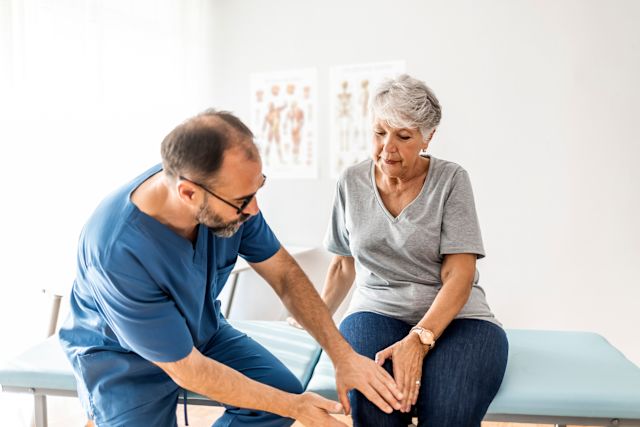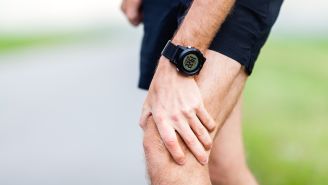Updated on January 4, 2024.
If you are living with osteoarthritis, you don't have to just grin and bear it. Although the condition cannot be cured, you may be able to ease pain, reduce stiffness, and even slow the progress of the disease by taking advantage of the wide variety of available treatments.
Speak with your healthcare provider (HCP) about what might work best for you. Your treatment will likely include one or more of the following.
Joint-friendly exercise
For many people with osteoarthritis, physical activity is a top treatment. Though it may seem counterintuitive, gentle, joint-friendly exercise can benefit you in many ways—by strengthening muscles, improving balance, relieving pain, and protecting you from worsening mobility and disability.
If you haven’t been exercising much, the Arthritis Foundation recommends starting small and gradually working up to 150 minutes of moderate-to-vigorous exercise each week. The best exercise program is multifaceted and includes:
- Strengthening exercises, which lower the stress on your joints by building up the neighboring muscles
- Stretching, which helps increase your range of motion and reduces stiffness
- Aerobic exercises, which help keep off excess weight and raise your energy and ability to do daily tasks
- Balance exercises, which strengthen muscles and help safeguard you from falling
A good fitness program is best created with the help of an HCP or physical therapist.
Physical and/or occupational therapy
A physical therapist can teach you exercises that help stabilize your joints, relieve pain, and improve your quality of living. An occupational therapist can help you learn to move in ways that ease everyday tasks and protect your joints. They can also advise you on the best assistive devices for your needs, including shoe inserts, braces, crutches, and canes.
Weight loss
Weight-bearing joints like the feet, ankles, knees, hips, and back can be stressed by extra pounds. What’s more, fat cells play a role in inflammation, which can affect joints.
Managing your weight can make a significant difference. According to the Arthritis Foundation, each 1 pound of excess weight that is lost equates to 4 pounds of pressure on your lower-body joints being removed.
Medication options
Medications can help on several fronts: They can help reduce pain, control swelling, and/or minimize inflammation in affected joints. No drug is one-size-fits-all, though. To adequately manage your symptoms, your HCP may recommend one medication or a combination, and they may be over-the-counter (OTC) or prescription drugs. The following drug categories that have been proven to effectively treat osteoarthritis.
Nonsteroidal anti-inflammatory drugs (NSAIDs)
Aspirin and other oral NSAIDs such as ibuprofen are safe and effective treatments commonly used for arthritis. Over-the-counter versions will treat pain, and higher doses of both OTC and prescription-strength NSAIDs will also help with inflammation. NSAIDs can have side effects, however, some of which may be quite serious. Short-term use—of about a week or two—makes these side effects much less likely. It’s best not to use oral NSAIDs long-term or if you have other conditions.
For people who’d rather not take oral NSAIDs—or who shouldn’t because of certain conditions—topical NSAIDs are applied directly to the skin and come in gels, creams, and patches.
Acetaminophen
While NSAIDs are popular, HCPs often choose acetaminophen as the first line of defense when it comes to relieving osteoarthritis pain. The drug has fewer potential side effects than what is commonly seen with long-term use of aspirin and other NSAIDs. Keep in mind: It's not an effective treatment for inflammation.
Corticosteroid injections
Also called glucocorticoids, these prescription medications work well at reducing inflammation and can provide quick, if brief, pain relief in the joint. They are usually injected directly into a joint, at an office visit with your HCP. However, corticosteroids aren’t really a long-term treatment possibility as there can be side effects—including damage to the joint—if the treatment is repeated too much or too often.
Surgery for osteoarthritis
An operation is a last resort for many people, but sometimes osteoarthritis progresses to the point where the pain can no longer be relieved by any other treatment. Fortunately, there is a wide variety of surgical techniques available—with varying recovery times—that can effectively relieve joint pain and restore function.
Joint replacement
Also called total joint arthroplasty, this procedure is often reserved for advanced cases of knee and hip osteoarthritis. Diseased or injured parts of the joint are surgically removed and replaced with artificial pieces. The new joint can last for many years—at least 15 years for knee replacements.
Osteotomy
This surgical technique reshapes and realigns the bones of arthritic joints so that they move against one another with less pressure and friction. This protects joints from more cartilage damage, inflammation, and pain. It can slow down the progression of osteoarthritis and relieve pain.
Arthrodesis
Also known as fusion, arthrodesis is an option when joint replacement fails or isn't possible. In this procedure, surgeons use rods or pins to join bones together, which encourages them to grow together and fuse. This can have serious complications, though.
There are many other types of surgical operations, including arthroscopy, joint resurfacing, synovectomy, and minimally invasive total joint replacement. Talk with your HCP or specialist to determine what is best for your situation.
Complementary therapies
From acupuncture to massage therapy to tai chi, many people find that mind-body treatments used alongside traditional medicine can help ease their osteoarthritis symptoms. But the evidence for some therapies is stronger than others, and certain practices may be harmful. Expert recommendations can vary depending on which of your joints are affected, too. For example, according to clinical guidelines issued by the American College of Rheumatology and the Arthritis Foundation, yoga may benefit some people with knee osteoarthritis, but not necessarily those with hand or hip issues.
If you’d like to try a complementary therapy, first have a conversation with your HCP. They can steer you towards practices that work best for your needs and steer you away from those that may hurt you in the long run.
Explore your options
Ultimately, the best therapeutic treatment for osteoarthritis is a multi-pronged and carefully tailored one. Ask your HCP or orthopedic specialist about the best options for you.







